Glycolysis is a complex process that is essential for the production of ATP, the body’s main energy currency. However, many people find glycolysis to be difficult to understand.
In this article, we will break down glycolysis into simple steps and explain how it works. We will also discuss how many net ATP molecules are produced by the glycolysis of one glucose molecule.
By the end of this article, you will have a clear understanding of glycolysis and how it produces ATP. You will also be able to answer the question: “How many net ATP molecules are produced by the glycolysis of one glucose molecule?”
To know about this question
How many net ATP molecules are produced by the glycolysis of one glucose molecule?
we will start with the basics from the start.
And the first question for this topic is:
How can we define GLYCOLYSIS?
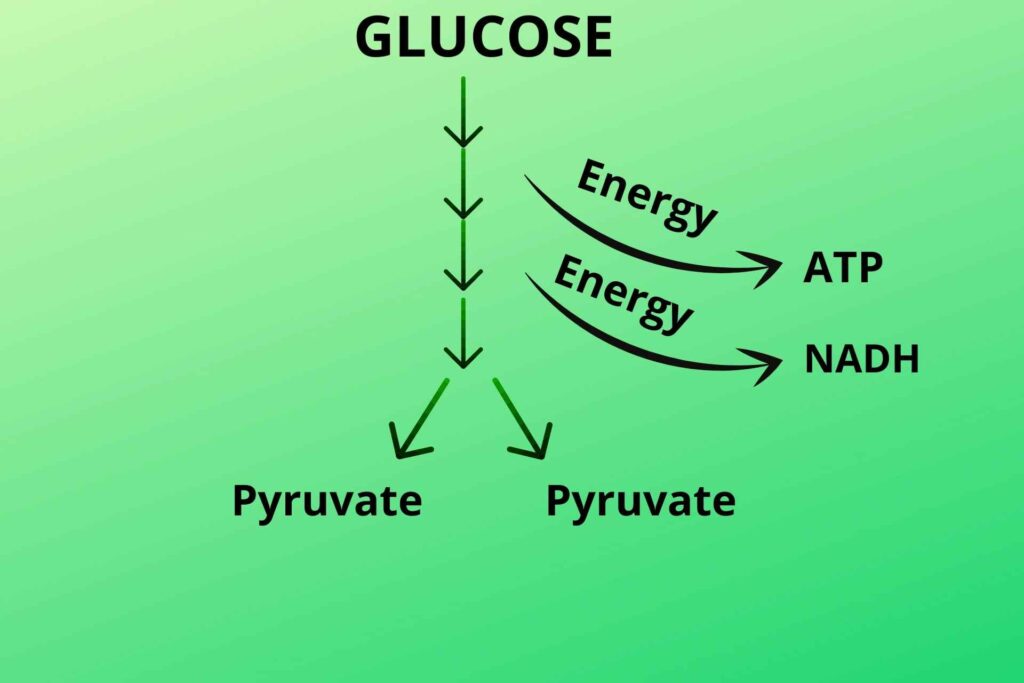
“Glycolysis is a metabolic pathway in which one molecule of glucose is broken down into 2 molecules of pyruvate with the release of energy in the form of ATP and NADH.”
Before going to glycolysis you should know some terms in advance so that it is easy to incoming details.
Okay.
After the formation of pyruvate, the glycolysis will move further to the next steps (Kreb’s cycle) in the presence of oxygen or it will stop after the formation of lactate from pyruvate.
Up to this step, it occurs in all cells but further steps depend on the type and kind of glycolysis.
What are these kinds of glycolysis?
These are either Aerobic glycolysis or Anaerobic glycolysis.
i. Aerobic glycolysis:
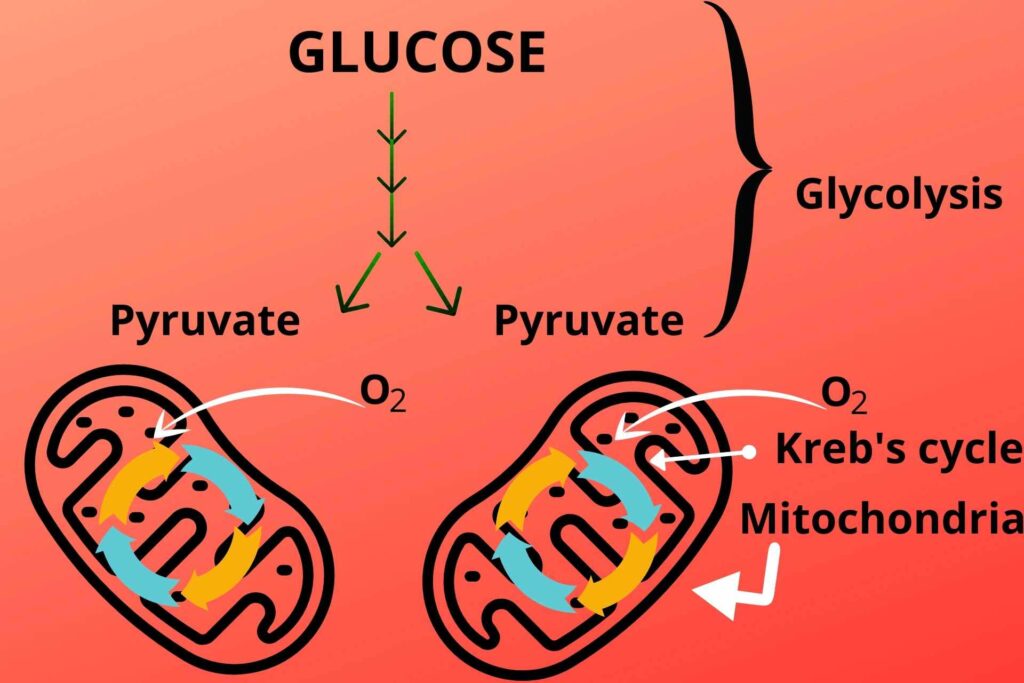
Aerobic glycolysis is the glycolysis that moves to a further step (Kreb cycle) if the oxygen and mitochondria are available and will produce more ATP.
ii. Anaerobic glycolysis:

As the name indicates glycolysis which does not proceed further because of the absence of oxygen and mitochondria. Pyruvate will change to lactate and will repeat the process which will be discussed later.

In some cases even the mitochondria are available but still, anaerobic glycolysis takes over because of severe hypoxia (lack of oxygen). Cells like RBC, Renal medulla, eye lens, and testes normally do anaerobic glycolysis but sometimes due to severe hypoxia (lack of oxygen) the cell switch to anaerobic glycolysis.

Sometimes during severe exercise, the oxygen demand is very high though the respiratory system is more active still the demand cannot be met then the cell starts anaerobic glycolysis.
As glycolysis requires glucose so now we will discuss the transport of the oxygen to the cell?
Transport of glucose:
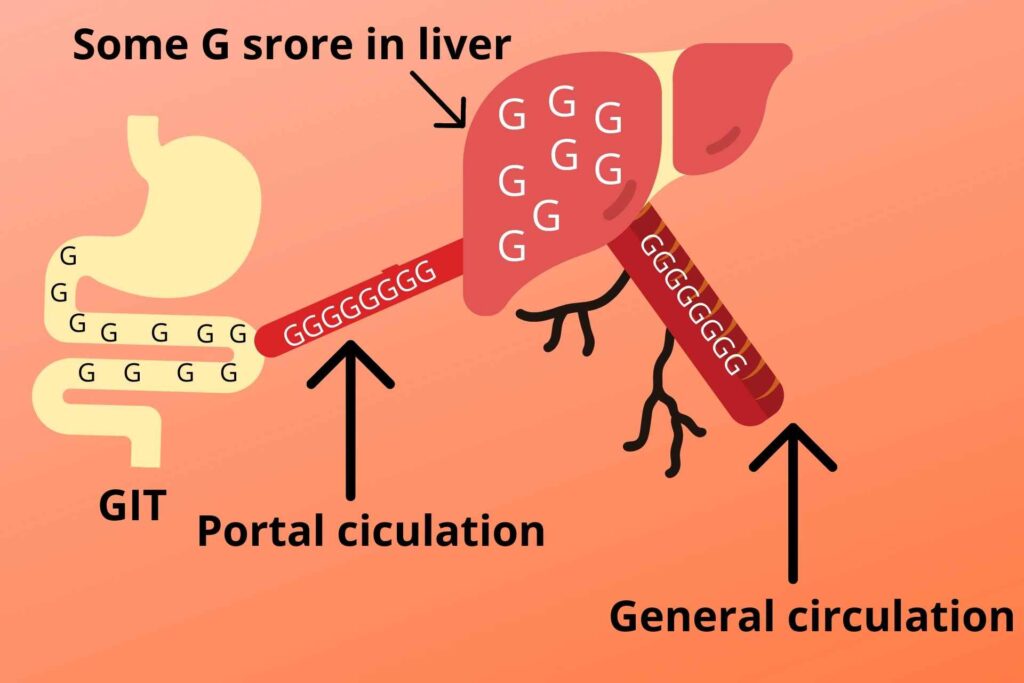
The glucose, fructose, and galactose from GIT (Gastrointestinal tract) are absorbed and move to portal circulation which is transported to the liver. The liver cells (hepatocytes) will store most of the glucose during eating to prevent the body from hyperglycemia and will release a small amount to general circulation. The hepatocytes also convert fructose and galactose to glucose.
But here we are talking about glucose transport to the cell. For this, we have to know about the glucose concentration between extracellular fluid and blood, and the concentration between extracellular fluid and cells.
The concentration of glucose between extracellular fluid and blood:
The concentration of glucose between extracellular fluid and blood is the same because glucose can move freely between blood and extracellular fluid.
The concentration of glucose between extracellular fluid and cell:
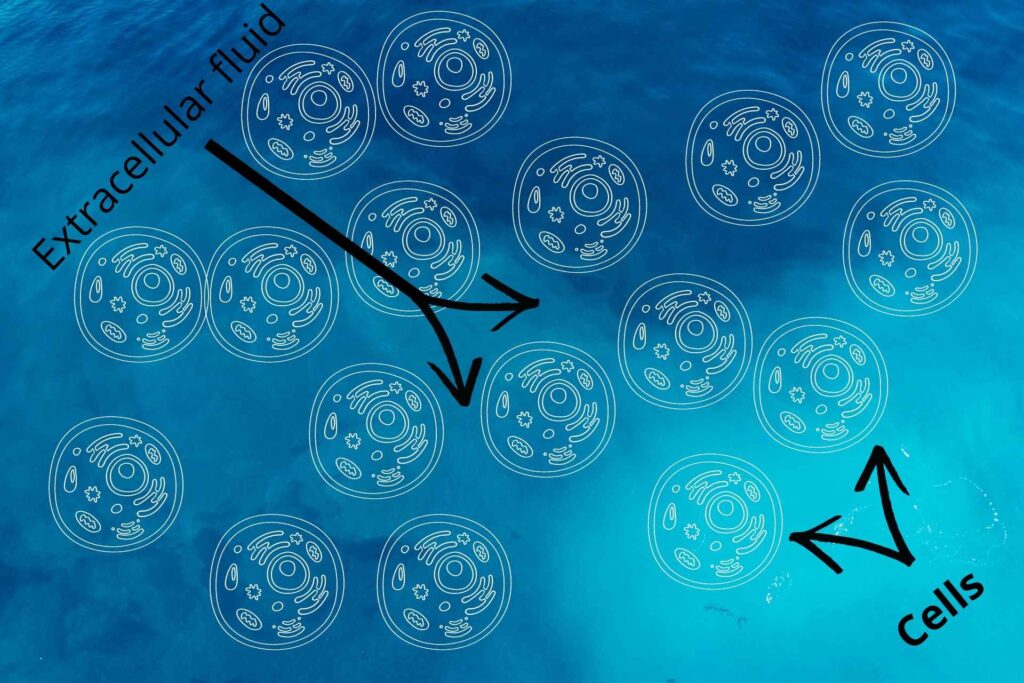
The glucose concentration between extracellular fluid and cell is not the same because glucose cannot move freely to the cell because it needs special transporter to move into the cell.
What are that special transporters?
On the basis of the transporter, the transport system is of two types.
- Facilitated diffusion
- Glucose-NA+-CO Transport
1. Facilitated diffusion
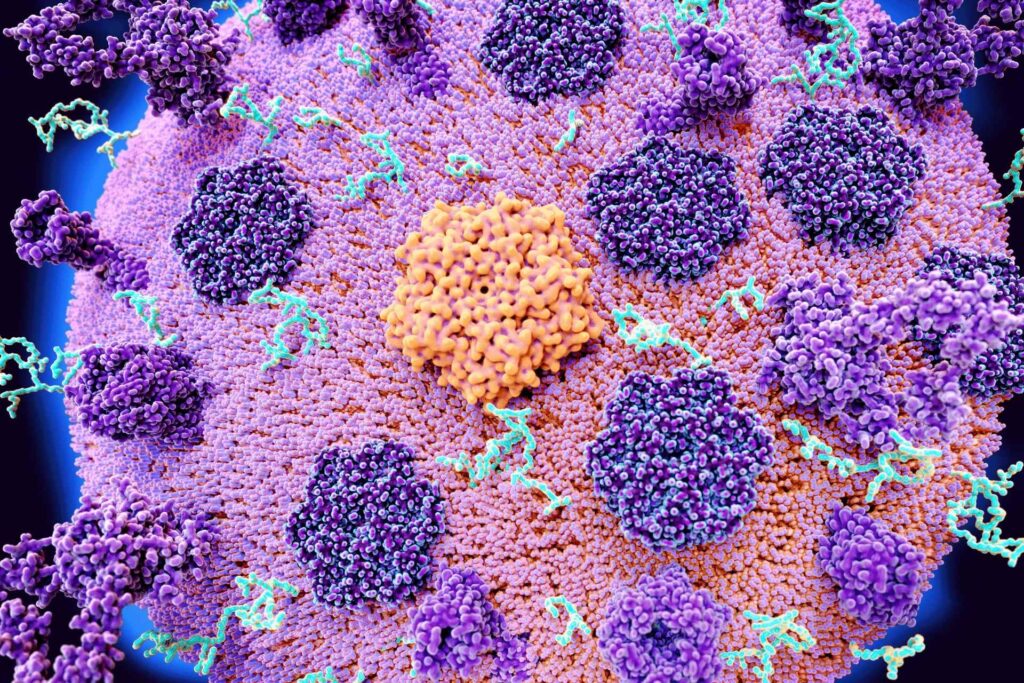
This is the type of diffusion that occurs through a special transporter protein called glucose transporter (GLUT).
Can you explain this process?
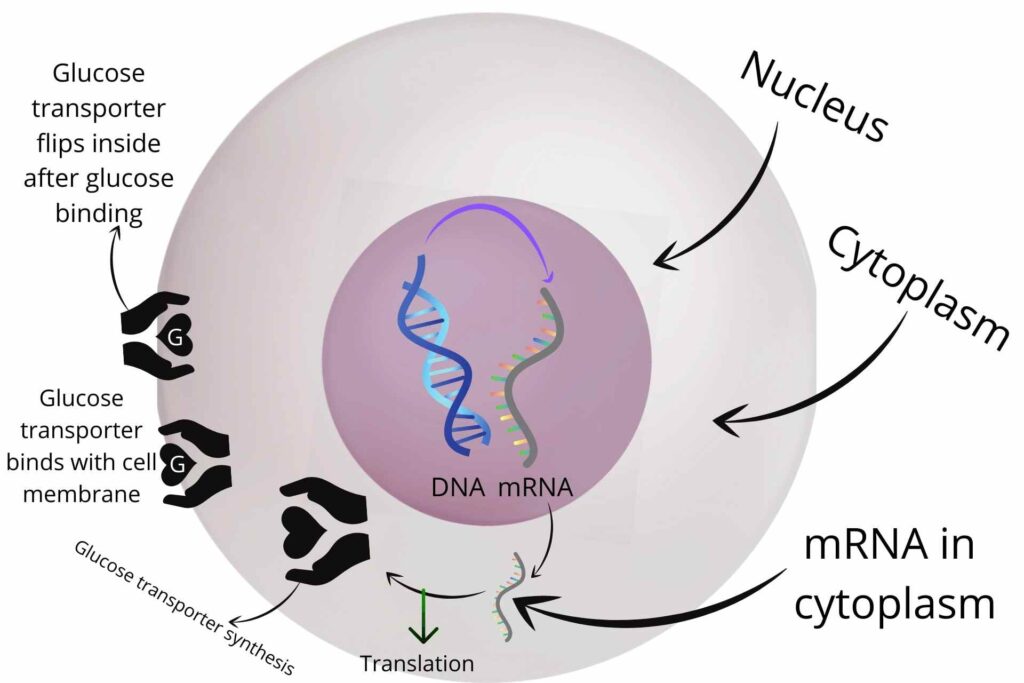
In the nucleus, there is a gene for glucose transporter (GLUT) which synthesizes mRNA and moves it to the cytoplasm where it synthesizes the glucose transporter (GLUT). After synthesis, it moves to the plasma membrane and attaches to it.
The structure of this protein is like opened hands for catching a ball through which glucose binds. After binding the protein transporter closes as the hands close after catching the ball and moving the glucose inside.
This is how glucose is transported to the cell.
Are there any other types of GLUT?
Yes, there are 6 types of GLUT which are the following.
- GLUT-1
- GLUT-2
- GLUT-3
- GLUT-4
- GLUT-5
- GLUT-7
1. GLUT-1 and GLUT-3:
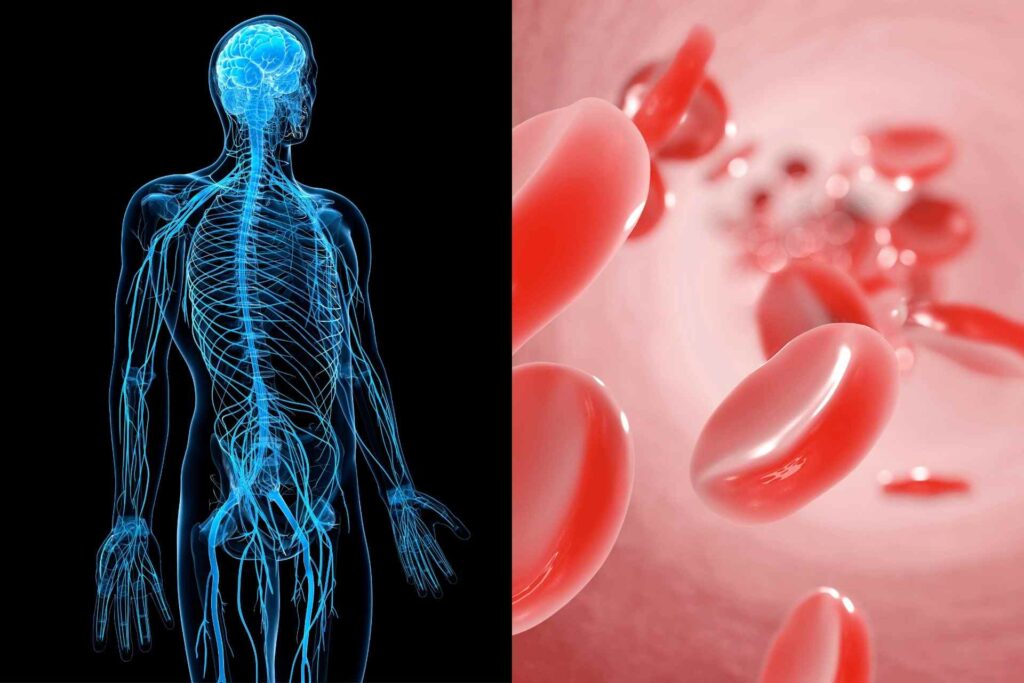
GLUT-1 and GLUT-3 are abundant in most tissues specially C.N.S and RBC. GLUT-1 and 3 freely move the glucose to the cell that’s why neurons have a large number of GLUT-1 and 3. Also, neuron needs a quick and continuous supply of energy which is possible through these carrier proteins.
2. GLUT-2:
The name indicates that GLUT-2 is a two-way transporter. For example when the glucose concentration is high in the blood then it moves to the cells like hepatocytes, adipocytes, and muscle cells but when the concentration of glucose is high in these cells then it moves back the glucose to the blood.
3. GLUT-4:
GLUT-4 is insulin-dependent when insulin is secreted it will work otherwise it will not work.
4. GLUT-5:
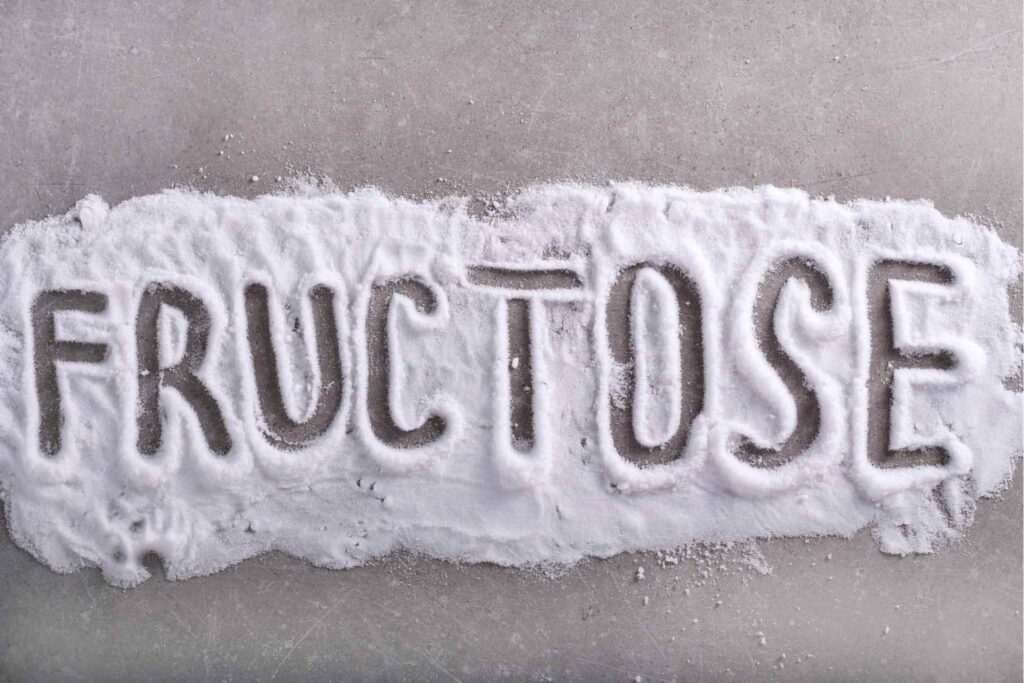
GLUT-5 are not glucose transporters, they are primarily fructose transporters. (Fructose is sweeter than glucose and testes love to run their metabolism on fructose). previously we said that fructose and galactose are converted to glucose and then it is transported to blood but some molecules of fructose don’t convert to glucose and are carried to testes and sperm by GLUT-5.
5. GLUT-7:
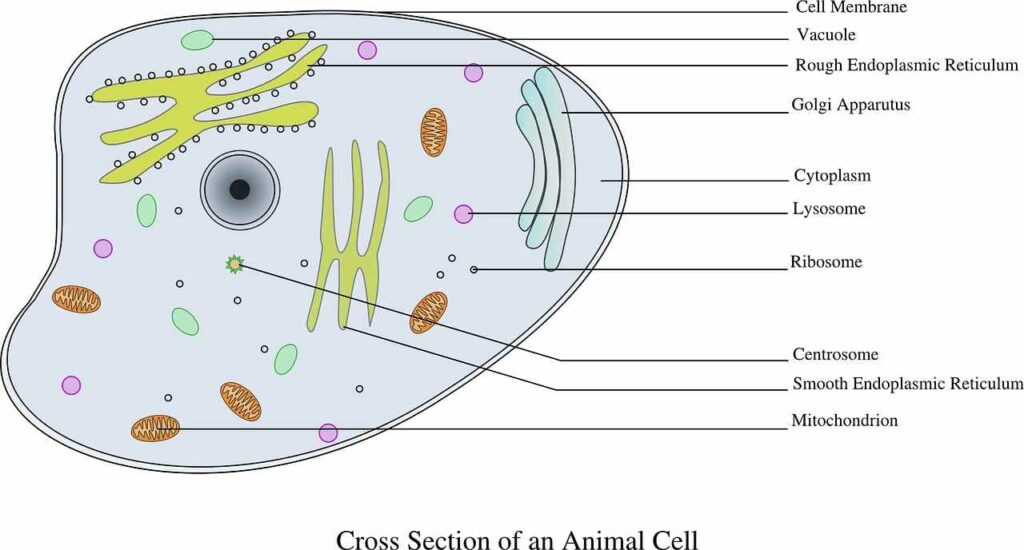
GLUT-7 is present in on smooth Endoplasmic Reticulum (SEM). The gluconeogenesis is carried out in the Smooth Endoplasmic Reticulum, that’s why these transporters are present there.
Steps of glycolysis:
Now here we are going to the real steps of glycolysis.
Steps 1:

As you know glucose is transported to the cell and now it is available. The first step in glycolysis is the conversion of glucose into glucose-6-phosphate with the use of one ATP.
Do you know why it is called “glucose 6 phosphate”?
No. Because phosphate is added to carbon no. 6, that’s why now it is called glucose-6-phosphate. The process of adding phosphate to a molecule is called phosphorylation.
From where does that phosphate come?
You must know that ATP has a phosphate group (3 phosphates) so the ATP provides a phosphate to the glucose and itself converted to ADP.
It means we invested energy here?
Exactly, it is an energy investment phase where we invested one ATP. To start a business we must invest cash first and then we will get their profit, the same is here too.
Is there any enzyme that works here?
Of course, this is an important question. The enzyme work here can be hexokinase or glucokinase.
Are both works the same?
Yes, both work the same.
Then why do they have different names?
Let’s explain this.
a. Glucokinase:

Glucokinase works on a higher concentration of glucose. And you know glucose concentration is high in liver cells (hepatocytes) so glucose works there.
Why does Glucokinase work on a high concentration of glucose?
Due to high Km and high Vmax.
What are these terms?
Don’t worry, let me explain these two terms.
i. Km
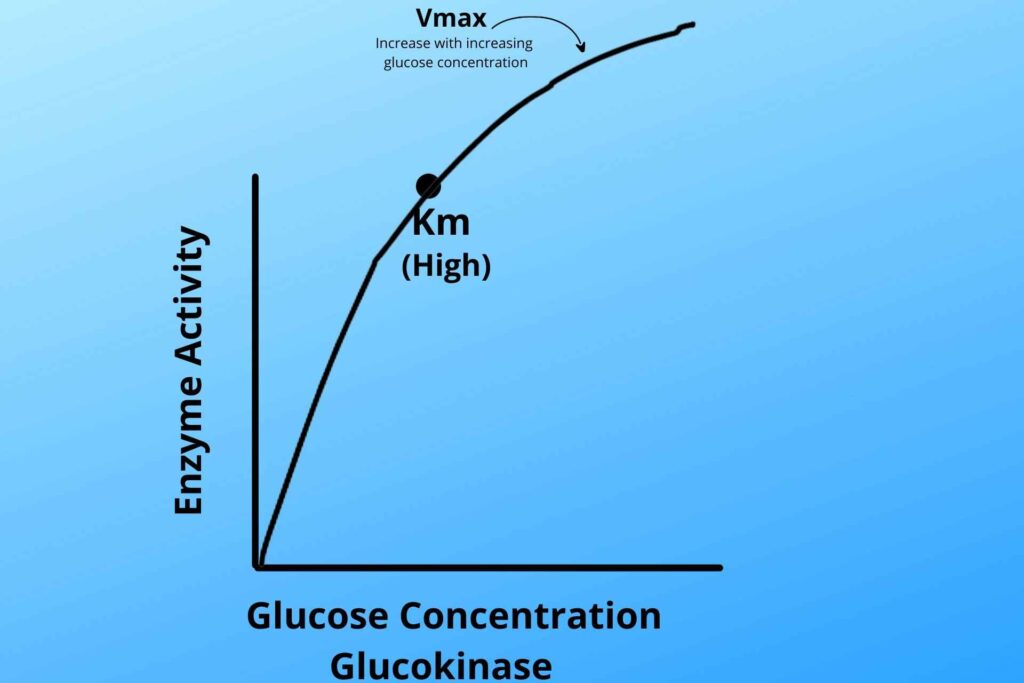
It is the concentration of substrate at which half of the enzyme is saturated.
Glucokinase has high km due to which it works on the high concentration of glucose to glucose 6 phosphate.
ii. Vmax:
Vmax is the velocity of the reaction at which it attains high speed.
Glucokinase has a high Vmax due to which it works on a high concentration of glucose.
Where this enzyme is present in the cell and how it is activated?
Glucokinase is present in a special area (protein) called “Glucokinase regulating protein” in the nucleus of hepatocytes. When the glucose level rises, it moves to the nucleus and activates glucokinase itself.
b. Hexokinase:
Opposite to glucokinase Hexokinase works on little glucose concentration. It means it is present in most tissues of the body.
Low km:

Hexokinase has a high affinity for glucose so it’s quickly become saturated and has low km.
Low Vmax:
As hexokinase has low km so it means it has also low Vmax because when it is quickly half saturated so its reaction won’t move high in speed making them low Vmax.
Where this enzyme is present in the cell?
This enzyme is present everywhere in the cytoplasm so it doesn’t need such an activation mechanism because it works on little glucose concentration.
Can you tell us how this enzyme secretion is controlled, I mean how does the cell know that these enzymes need to be stopped?
That’s a good question.
After the formation of glucose-6-phosphate, it signals to the enzyme to stop its secretion and activity.
This first step in glycolysis is a one-way pathway, which means this enzyme can’t back this step in reverse.
That’s good and easy.
Step 2:
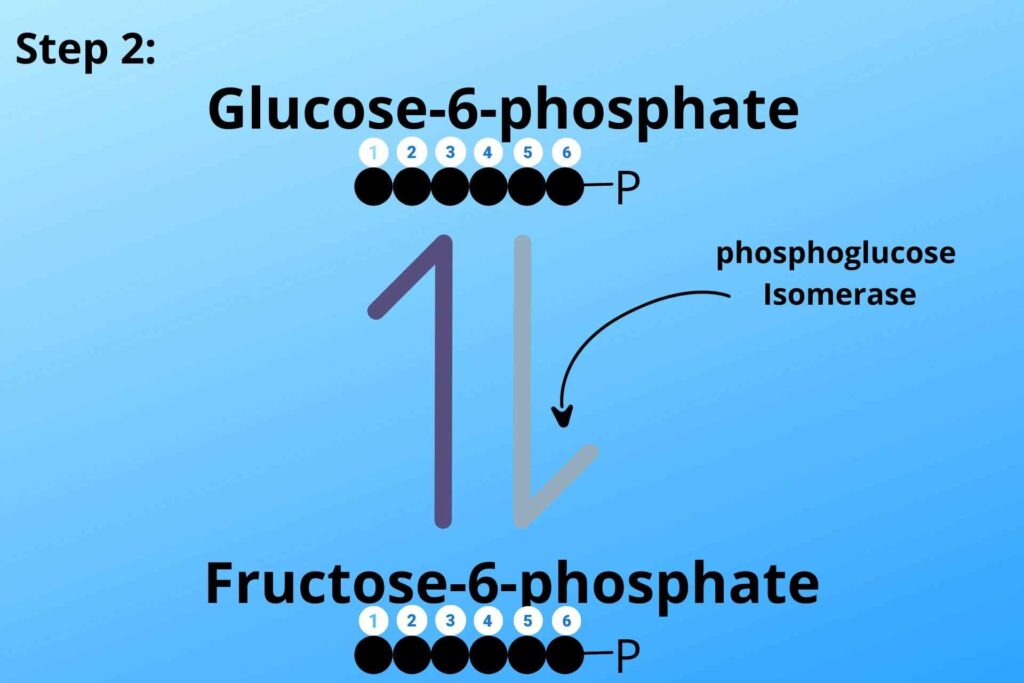
The second step in glycolysis is the conversion of Glucose-6-phosphate to Fructose-6-phosphate. Carbon numbers are the same in both molecules i.e. glucose and fructose, but the difference is only in their orientation of carbon and hydrogen.
There must be an enzyme that is doing this step?
Yes, every step in glycolysis requires an enzyme for conduction. The enzyme which is acting here is phosphoglucose isomerase.
Why there is no investment in ATP?
Because there is no need for phosphorylation of glucose-6-phosphate or Fructose-6-phosphate.
It is easy then, the step where phosphate is added requires ATP.
Exactly, now you got the point.
This step is reversible because the phosphoglucose isomerase enzyme can reverse back this step.
Step 3:
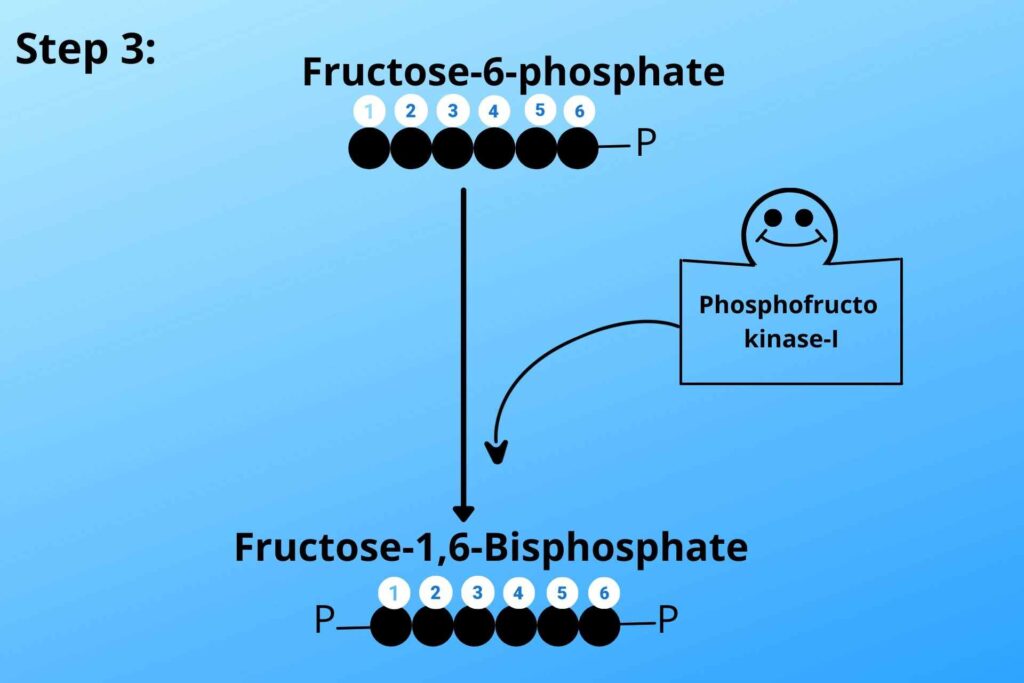
In the third step, Fructose-6-phosphate is converted to Fructose 1, 6 Bisphosphate.
Did you guess anything here?
Oh yes, again ATP is invested here for adding phosphate to Fructose-6-phosphate.
Absolutely right.
Again can you tell us which enzyme acts here?
Phosphofructo kinase-1 is the enzyme that runs this step.
And do you know why it is called Phosphofructo kinase-1?
Look at the product of this step, Fructose 1, 6 Bisphosphate, and the previous step product, Fructose-6-phosphate.
What did you observe?
Additional phosphate on carbon-1.
That’s your answer, Phosphofructo kinase-1 adds phosphate at carbon-1 that’s why it is called Phosphofructo kinase-1. The “1” in Phosphofructo kinase-1 shows the number of carbon to which it has added phosphate.
How this enzyme is activated?
This enzyme works in many influences and proceeds the reaction in the forward direction.
What are these influences?
Regulator 1:
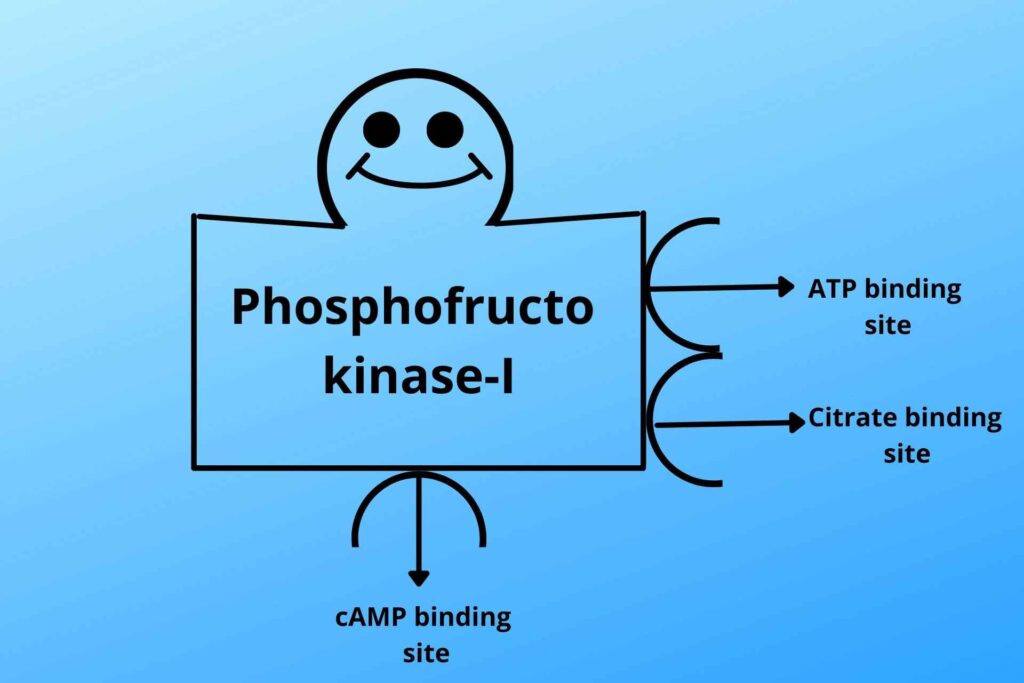
Before going to explain this, let me explain the structure of this enzyme. Phosphofructo kinase-1 has special binding points where different molecules bind for stimulation. The diagram shows one point for ATP, the other is for citrate (produce in the Krebs cycle), and the third one is for cAMP (cyclic AMP).
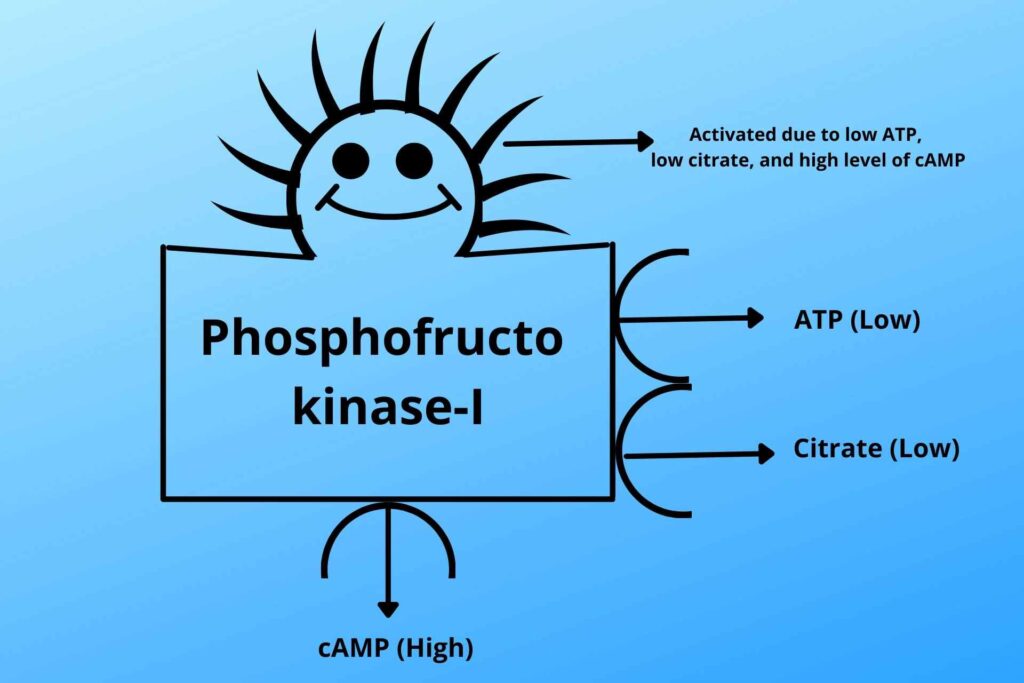
For example, the cell has low ATP and citrate while the concentration of cAMP is high, it means the cell has used a lot of ATP and produced a lot of cAMP which binds to the cAMP point while a low concentration of ATP and citrate binds to their points signaling the enzyme to work.
In contrast, if the level of ATP and citrate is high and the concentration of cAMP is low it means that the cell has enough energy so it will signal the enzyme to stop their action.
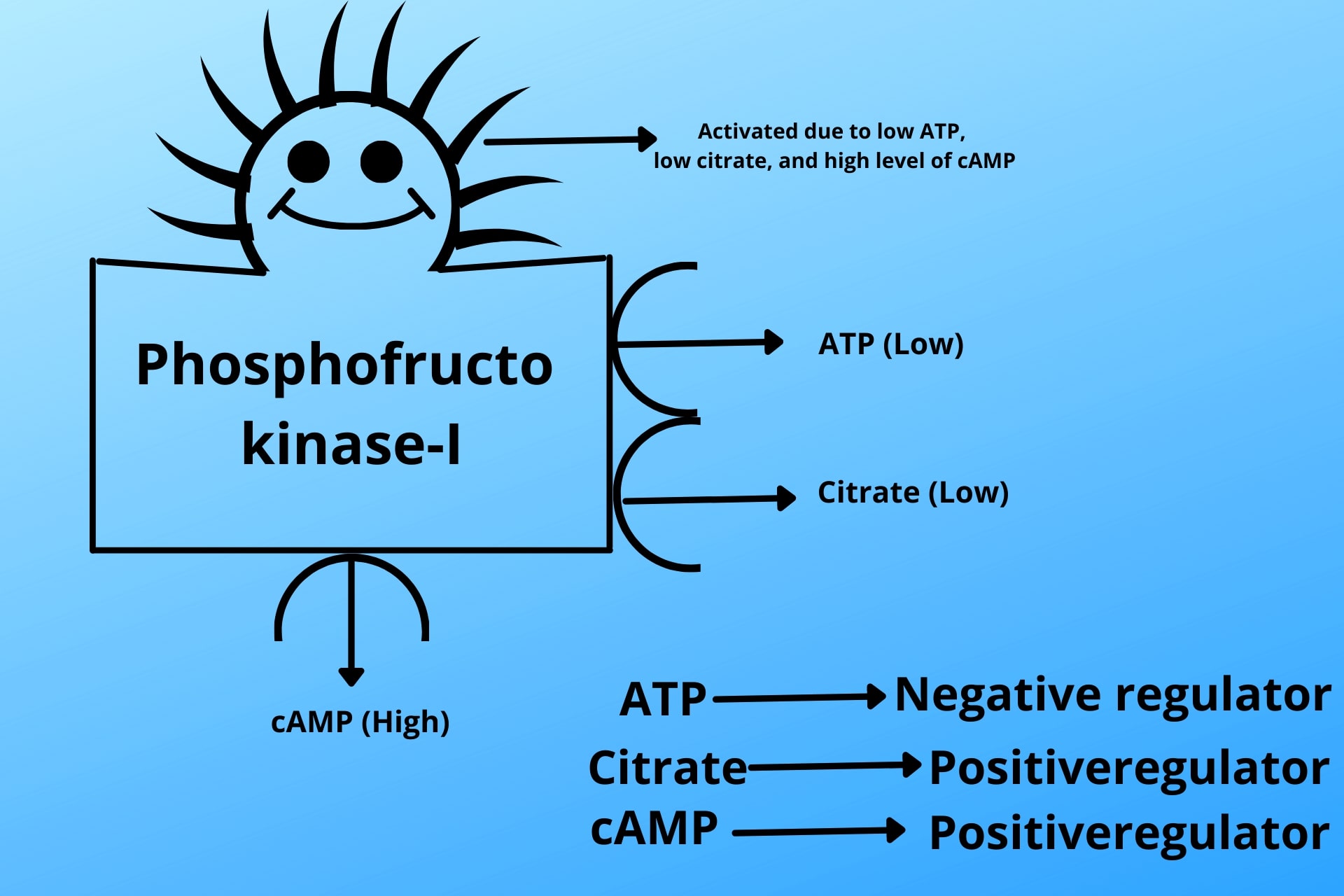
So cAMP is the positive regulator of Phosphofructo kinase-1 because their high level stimulates this enzyme while ATP and citrate are the negative regulators of this enzyme because their high concentration signals the cell to stop their action.
Regulator 2:
This is the super-regulator and activator of the Phosphofructo kinase-1 enzyme.
How?
Let me ask you?
Do you remember step 3 where Fructose-6 phosphate was converted to Fructose 1, 6 bisphosphate?
Yes, I remembered it.

During this conversion, a very little number of molecules (e.g 2 out 10) is converted to Fructose 2, 6 bisphosphate which superbly activates Phosphofructo kinase-1 to convert Fructose-6-phosphate into Fructose2, 6 bisphosphates very rapidly.
But who converts this to Fructose 2, 6 bisphosphate?
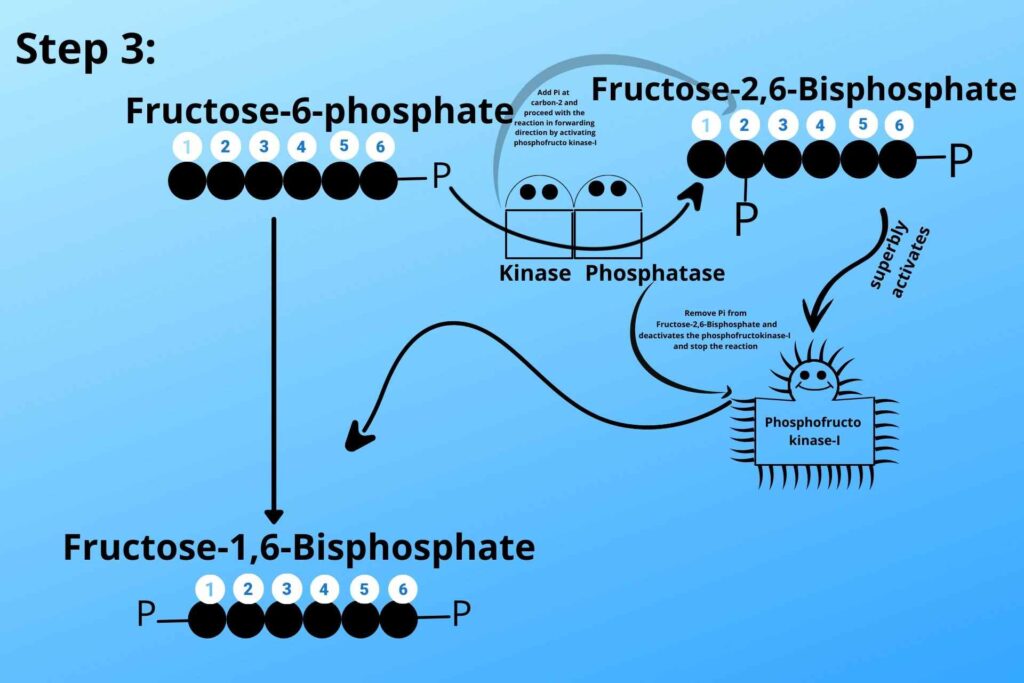
The enzyme. The enzyme which is converting this is very interesting because it has both the adding and removing the ability of phosphate from this molecule. It is like a hermaphrodite character.
Can you tell us in simple words what enzyme actually is?
In simple words this enzyme has two parts, one has kinase activity i.e. phosphofructokinase-II (which adds phosphate to a substance i.e. phosphorylation) while the other has phosphatase activity i.e. phosphofructophosphatase. (which removes phosphate from the molecule).
What is meant by kinase activity and phosphatase activity?
Well, remember, those enzymes which have kinase in their name, meaning that the enzyme adds phosphate to the molecule while the phosphatase enzyme removes the phosphate from the molecule. So it is concluded from this that the kinase enzyme proceeds with the glycolysis in the forward direction while the phosphatase enzyme stops and reverses the glycolysis.
But how this hermaphrodite enzyme will know which part of this enzyme should work i.e. kinase or phosphatase?
For this let me take two conditions of glucose levels in the blood.
Which are these two conditions?
You should guess but by the way, I will tell you.
- A low blood glucose level
- A high blood glucose level
1. Low blood glucose level
When blood glucose level is low so there is less glucose in the blood.
Do you think this is the time for glycolysis?
No, it is obvious if the glucose level is low in the blood then there is less availability of glucose for glycolysis so it is not the time for glycolysis.
Coming to the hormone, do you know which hormone is high during low blood glucose levels?
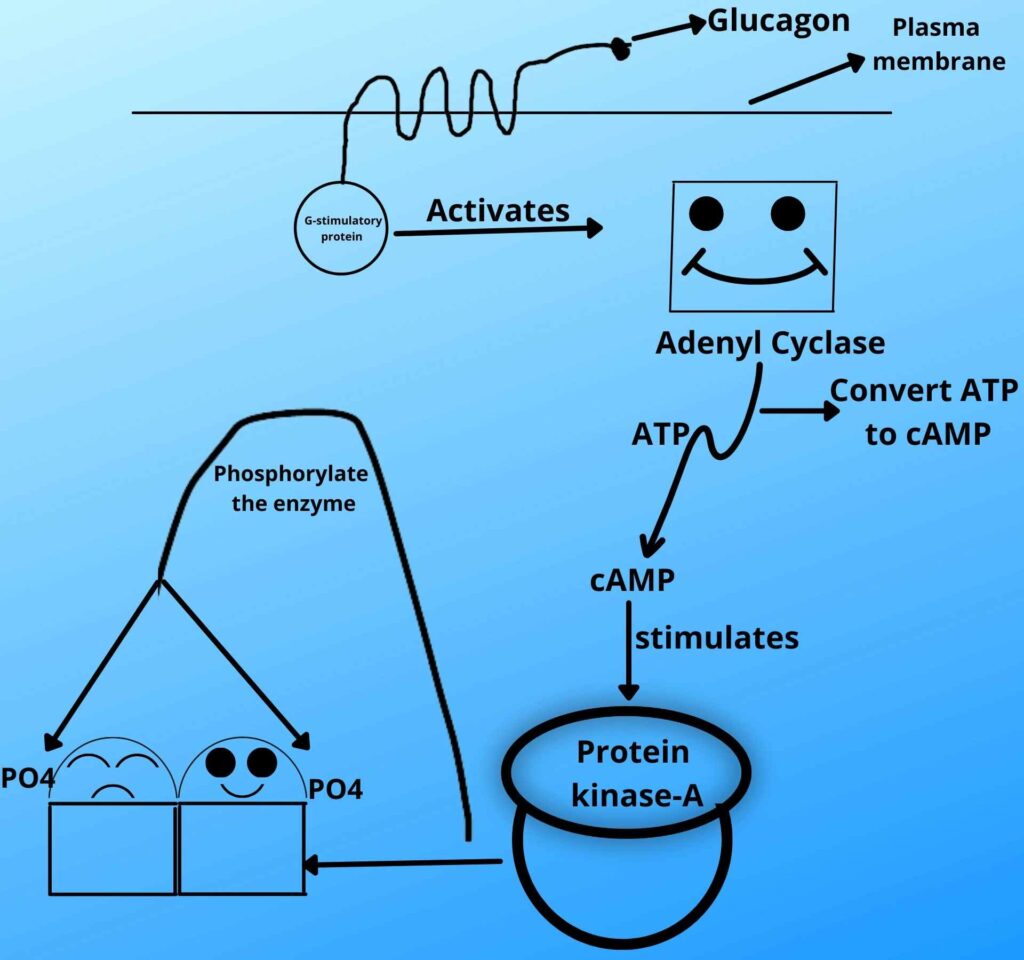
Glucagon (glucose gone, just for remembering), when the glucose level is low, glucagon is released to convert stored glycogen to glucose.
Okay, listen carefully due to the low level of glucose glucagon binds with its receptor on the plasma membrane and this stimulated receptor is then coupled with G-stimulatory protein in the cell.
Okay.
The G-stimulatory then stimulates adenyl cyclase which converts ATP to cAMP (cyclic AMP) and the number of cAMP in the cell increases. The cAMP in turn activates the protein kinase A enzyme which phosphorylates the hermaphrodite enzyme.
Will both parts of this enzyme be activated?
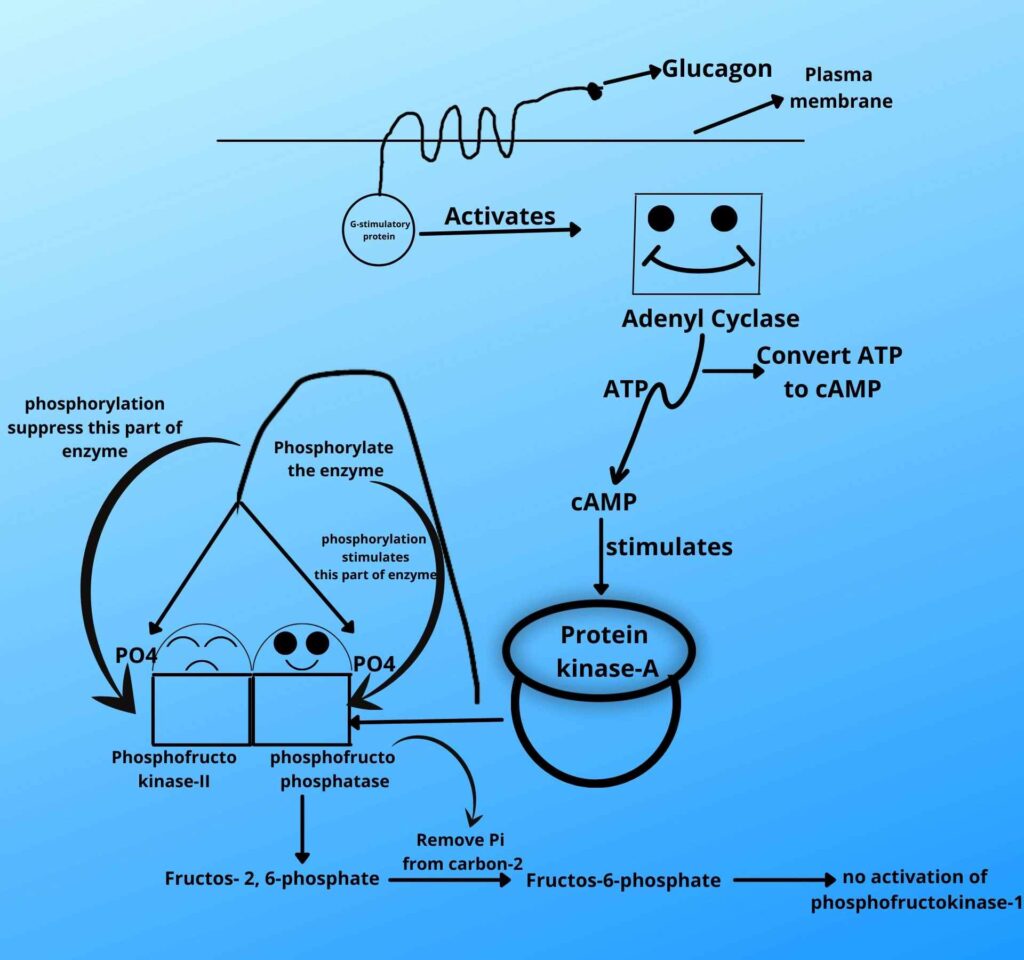
No, phosphorylation is like pressure on the hermaphrodite enzyme in which the kinase is suppressed and the phosphatase domain which is called phosphofructo phosphatase will be activated.
Now, what will the phosphatase enzyme do?
As already discussed the phosphatase (phosphofructo phosphatase) enzyme removes the phosphate group, so it will remove the phosphate from Fructose 2, 6 phosphates, and will convert it back to the step 2 product i.e. Fructose-6-phosphate.
After this what will be happened?
As the Fructose 2, 6 phosphates are converting back to Fructose-6-phosphate the concentration of Fructose 2, 6 phosphates will decrease, and when Fructose 2, 6 phosphate decreases there will no activation of phosphofructokinase-1 so the conversion of Fructose-6-phosphate to Fructose 2, 6 phosphate stops and the glycolysis will be arrested.
2. High blood glucose level
When blood glucose level rises the previous process stops i.e. glucagon secretion and there is high availability of glucose.
You must know which enzyme is secreted during high glucose levels to release energy?
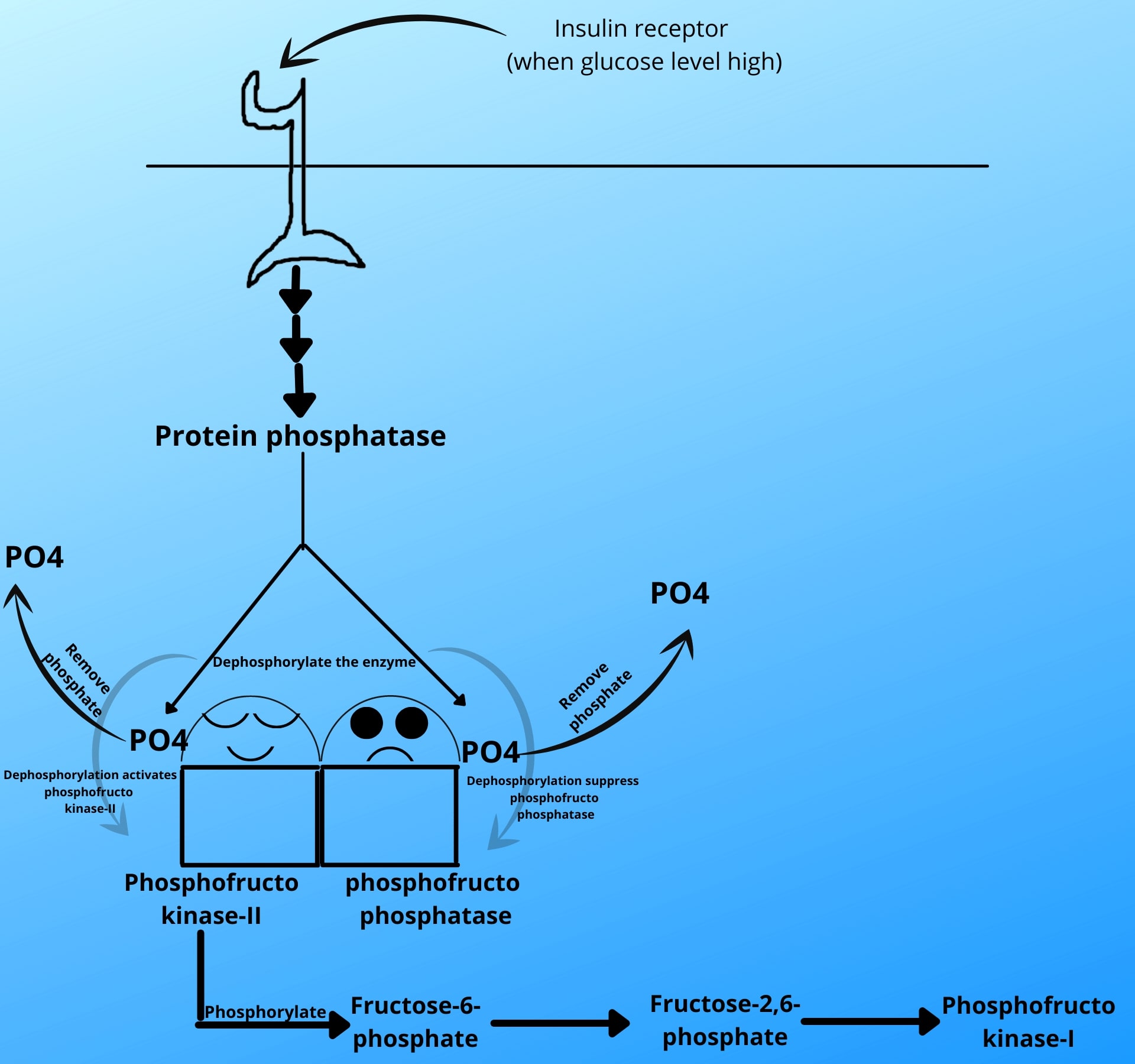
Yes I know, the enzyme during high blood glucose levels is insulin.
Again it will bind to the receptor on the plasma membrane?
Absolutely you are right, as you are seeing in the picture the insulin is bounded with its receptor on the plasma membrane, and through a series of reactions, it will activate a special type of protein phosphatase which will remove phosphate from the hermaphrodite enzyme.
After this, the phosphatase domain of hermaphrodite which is known as phosphofructokinase-2 is activated.
Is it going to phosphorylate “fructose-6-phosphate” to “fructose 2, 6 bisphosphates”?
Exactly, it will phosphorylate fructose-6-phosphate to fructose 2, 6 bisphosphate which in turn activates the phosphofructokinase-1 and the glycolysis will proceed forward.
Step 4:
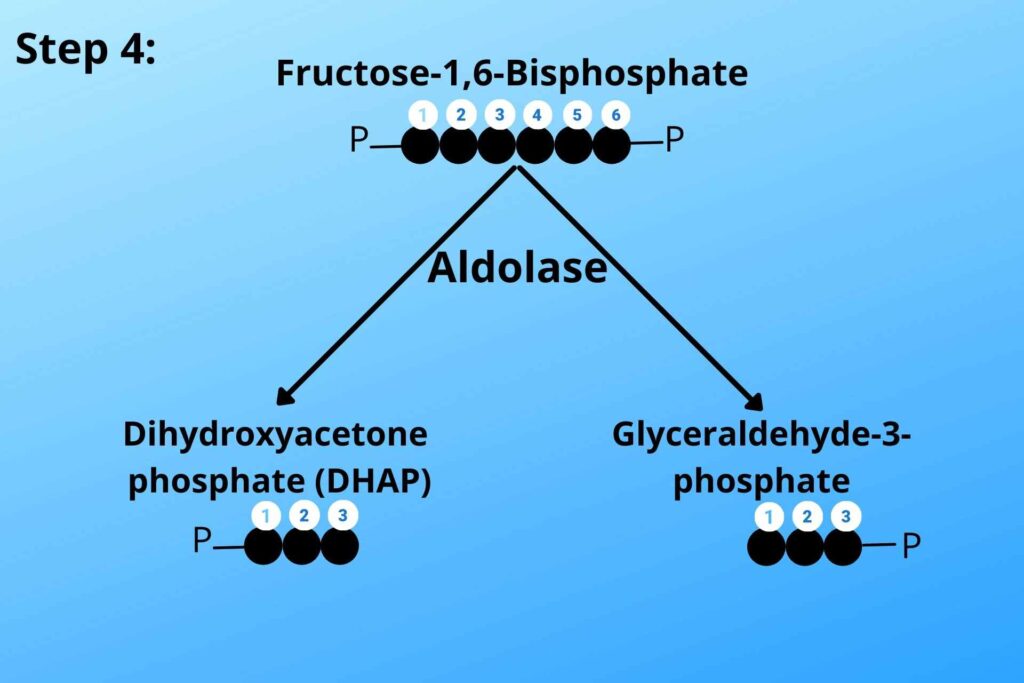
In step 4 an enzyme known as Aldolase will come and cut the six-carbon Fructose 1, 6 bisphosphates into two molecules of 3 carbon compounds i.e dihydroxyacetone phosphate (DHAP) and Glyceraldehyde-3-phosphate. The dihydroxyacetone phosphate (DHAP) has phosphate on carbon-1 while Glyceraldehyde-3-phosphate has phosphate on carbon-3 as their name indicates.
Now the reaction will proceed on two sides, left and right as in the picture to produce two pyruvates.
But how? Because both sides have two different types of molecules i.e. dihydroxyacetone phosphate (DHAP) and Glyceraldehyde-3-phosphate?
Good question.

The dihydroxyacetone phosphate (DHAP) is first converted to Glyceraldehyde-3-phosphate by triose phosphate isomerase enzyme so that both sides have the same product for further steps.
Up to these steps, glycolysis invested energy in the form of ATP.
That’s good.
Step 5:
From now both sides’ steps will be the same. From now it will be energy-getting steps.

In this step, Glyceraldehyde-3-phosphate is converted to 1, 3 bisphosphoglycerates by glyceraldehyde-3-phosphate dehydrogenase enzyme with the conversion of NAD+ to NADH+H.
From where the phosphate is received, did we invest in ATP again?
No, let’s back to the enzyme works here i.e. glyceraldehyde 3-phosphate dehydrogenase. This enzyme has multiple points where different molecules bind. At one point inorganic phosphate binds, and the second and third points bind NAD+ and substrate (Glyceraldehyde-3-phosphate).
But both molecules i.e. “Glyceraldehyde-3-phosphate and 1, 3 bisphosphoglycerate” are 3 carbon compounds?
Yes, to produce and gain energy.
During this step, a lot of energy is produced which is trapped by NADH (one NADH produces 3 ATP in the electron transport chain in the presence of oxygen and mitochondria) but still, there is energy that binds inorganic phosphate from glyceraldehyde 3-phosphate dehydrogenase to Glyceraldehyde-3-phosphate to make it 1, 3 bisphosphoglycerate.
Step 6:
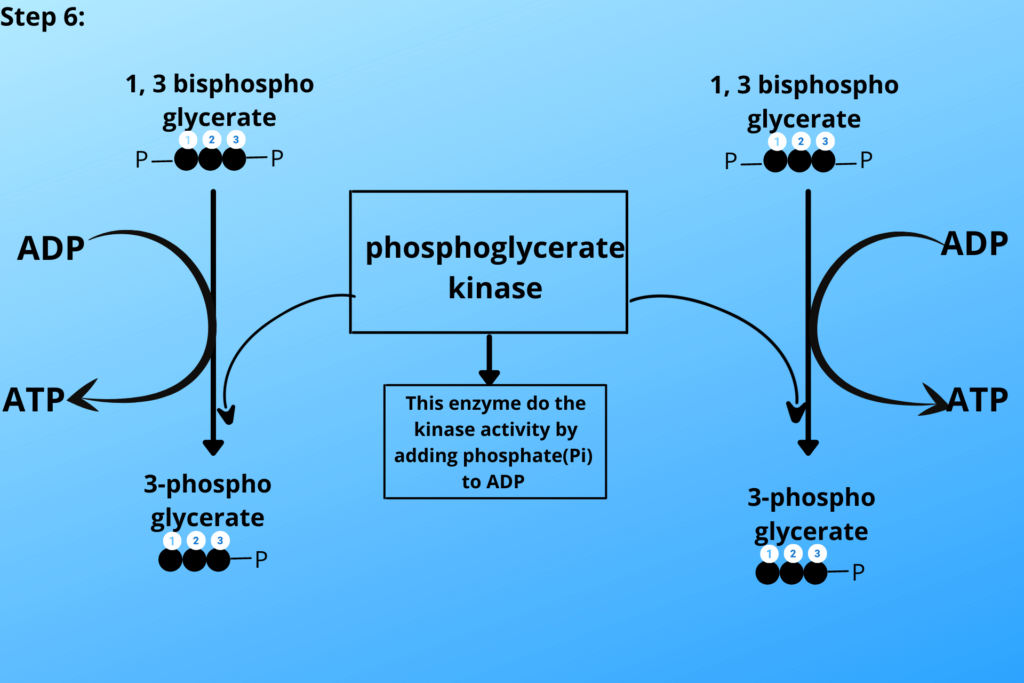
The 1, 3 bisphosphoglycerate has 2 phosphates on carbon 1 and carbon 3. The enzyme phosphoglycerate kinase in this step removes the phosphate from carbon-1 and produces 3-phosphoglycerate.
But we have studied that kinase adds phosphate to a molecule and here it removed the phosphate?
Excellent question, this enzyme is doing kinase activity with ADP to convert it to ATP, not with 1, 3 bisphosphoglycerates.
And where the phosphate is gone?
Excellent, you are really attending the class. The phosphate is used to convert ADP to ATP in this step so it is a profit step in which we get 2 ATP from both sides of glycolysis as shown in the picture. Up to now the net gain of ATP is zero because we have invested two ATP in the initial steps.
Do you know?
What?
This phosphorylation of ADP to ATP is called substrate-level phosphorylation.
Can you explain more, please?
In this type of phosphorylation, we did not use oxygen, mitochondria, and the electron transport chain. Here the substrate 1, 3 bisphosphoglycerate donated phosphate directly to ADP so we call it substrate-level phosphorylation.
Is this necessary?
Much, because some cell doesn’t have mitochondria so they depend on substrate-level phosphorylation though some cells have mitochondria but there is a severe deficiency of oxygen (hypoxia) so still cells depend on substrate-level phosphorylation.
Is there any term opposite to “substrate-level phosphorylation”?
Oxidative phosphorylation is opposite to it. It occurs in the presence of oxygen in mitochondria.
Step 7:
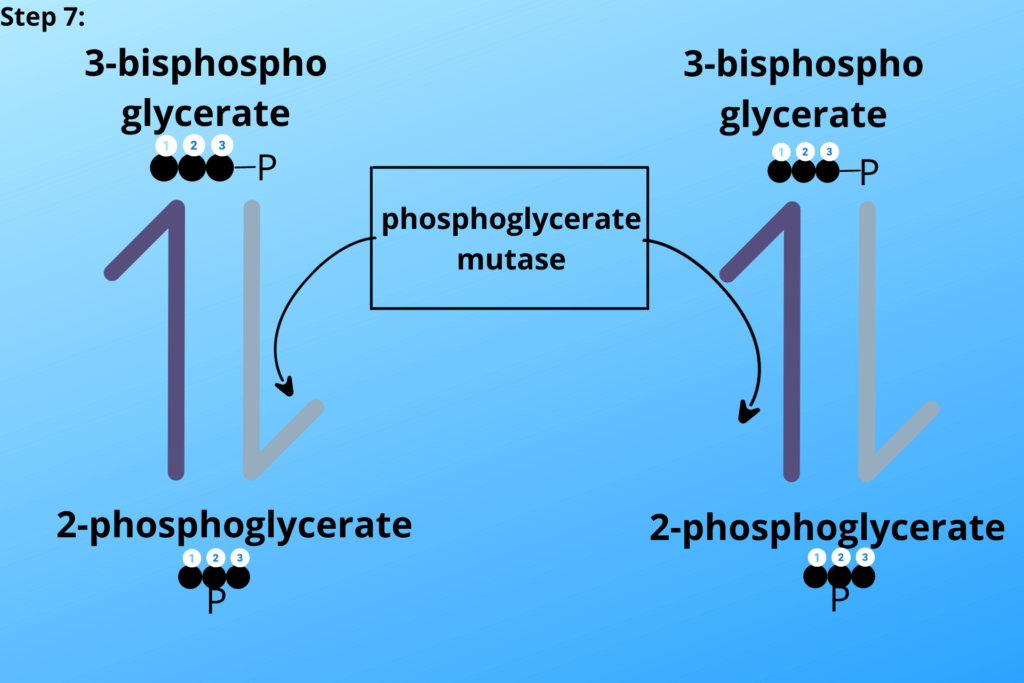
Still, 3 phosphoglycerate has phosphate on carbon-3. Still, there is a chance to make a new phosphate so the cell wants to remove it to make a new ATP. For this, the enzyme phosphoglycerate mutase comes and converts 3-phosphoglycerate to 2-phosphoglycerate to make the phosphate removal easier in the next step.
Step 8:
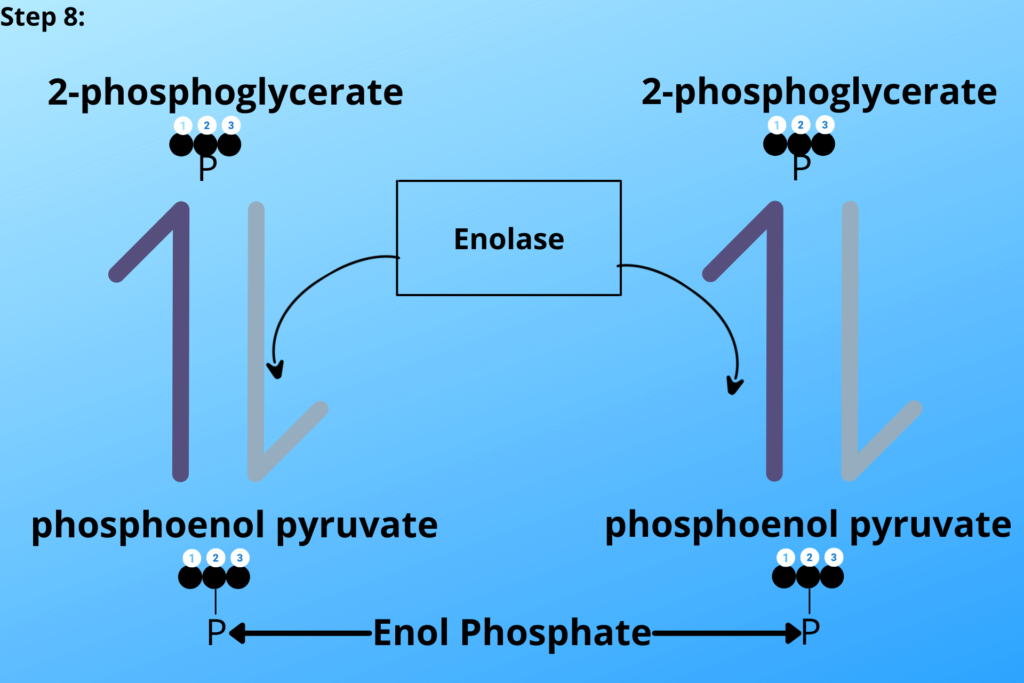
As in the previous step, phosphate was moved from carbon-3 to carbon-2. Here the enzyme Enolase twists the molecule to make the phosphate ready to leave (not removed yet) as shown in the picture. Now this phosphate is called Enol phosphate and the product is called phosphoenolpyruvate.
Step 9:
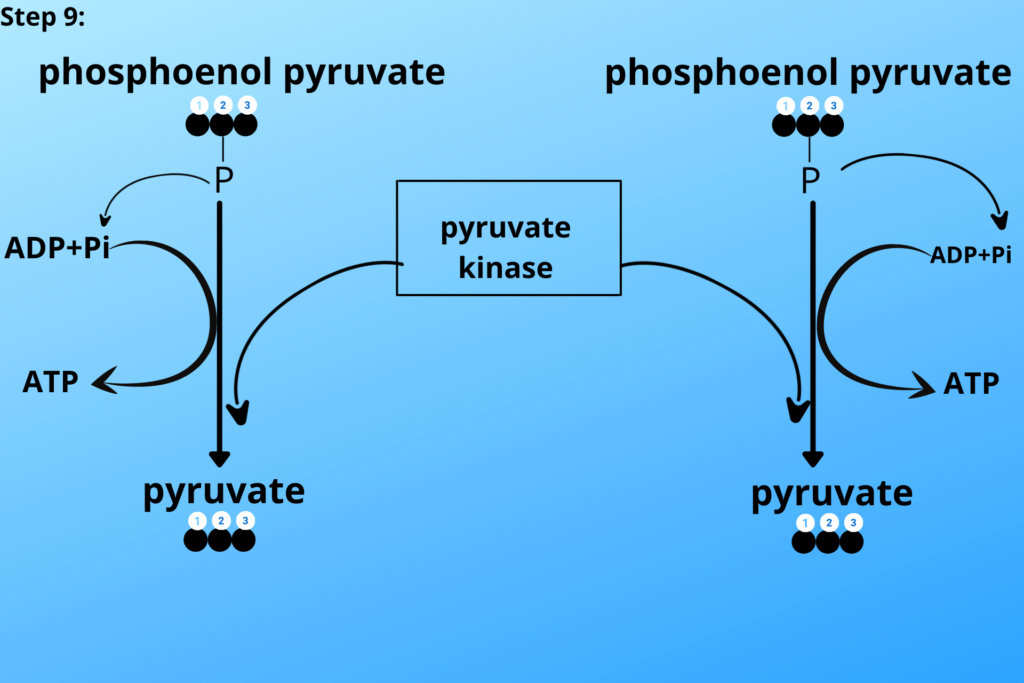
In this last step, the enol phosphate is removed from phosphoenolpyruvate and is converted into pyruvate by the pyruvate kinase enzyme.
Will you ask again where the phosphate is gone?
Absolutely not, I know this phosphate is used to generate ATP from ADP. A total of 2 ATP is generated in this step and this type of phosphorylation of ADP to ATP is called substrate-level phosphorylation because no oxygen is involved.
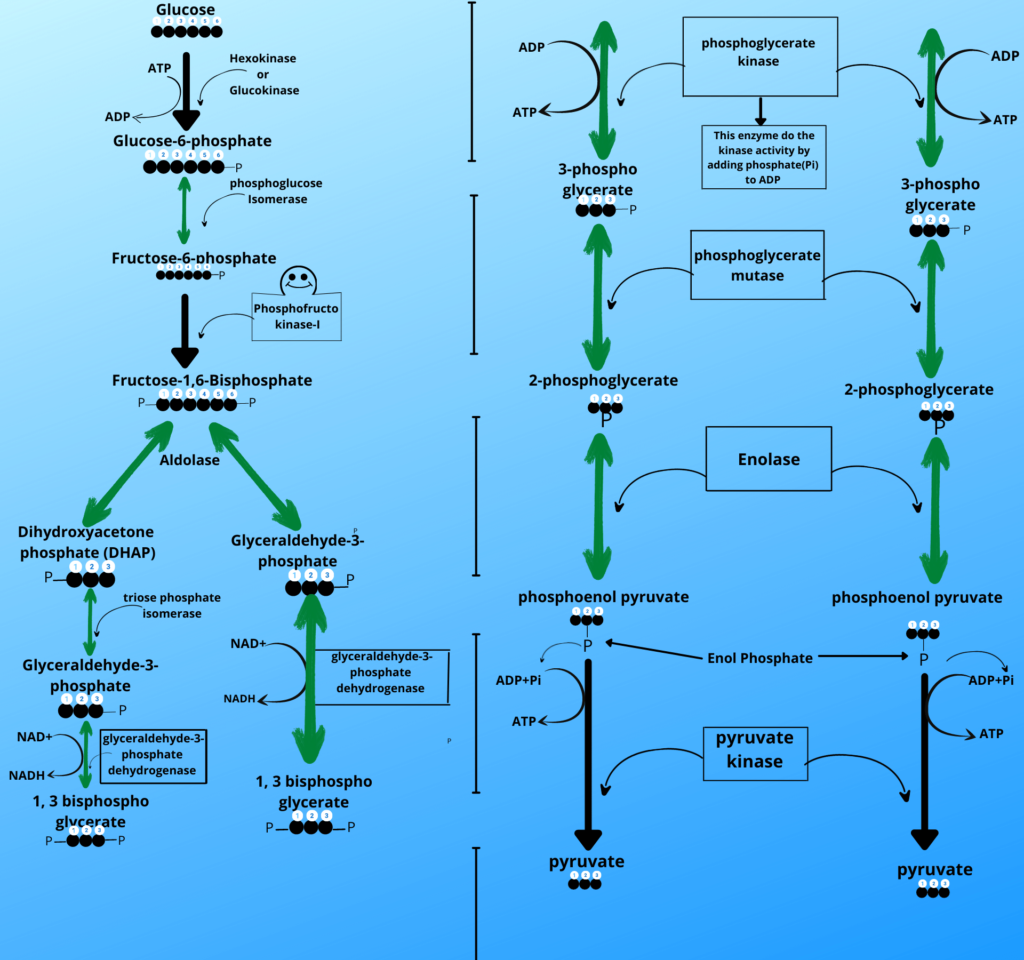
Let me give you these all steps in one picture so that you can understand better after understanding them one by one step.
Do you know which steps are irreversible in glycolysis?
No.
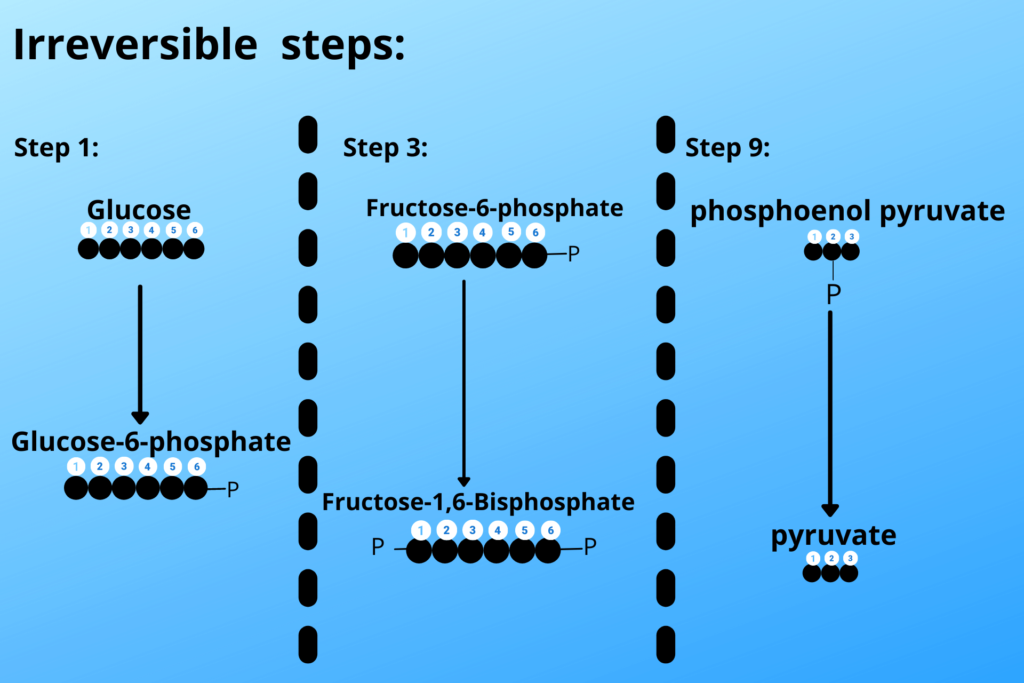
Let me tell you, step-1 (glucose to glucose-6-phosphate) is irreversible which means the enzyme (glucokinase or hexokinase) in this step can’t reverse the reaction.
Step-3 (Fructose-6-phosphate to Fructose 1, 6 bisphosphates) and step-9 (phosphoenolpyruvate to pyruvate) are also irreversible.
Why it is so important?
It is very important because in Gluconeogenesis these steps are a hurdle to reverse the reaction to produce a new glucose molecule.
Do you know how many ATPs we invested and how many we got?
If you explain it will be good.
Okay, let me explain to you in a diagram.
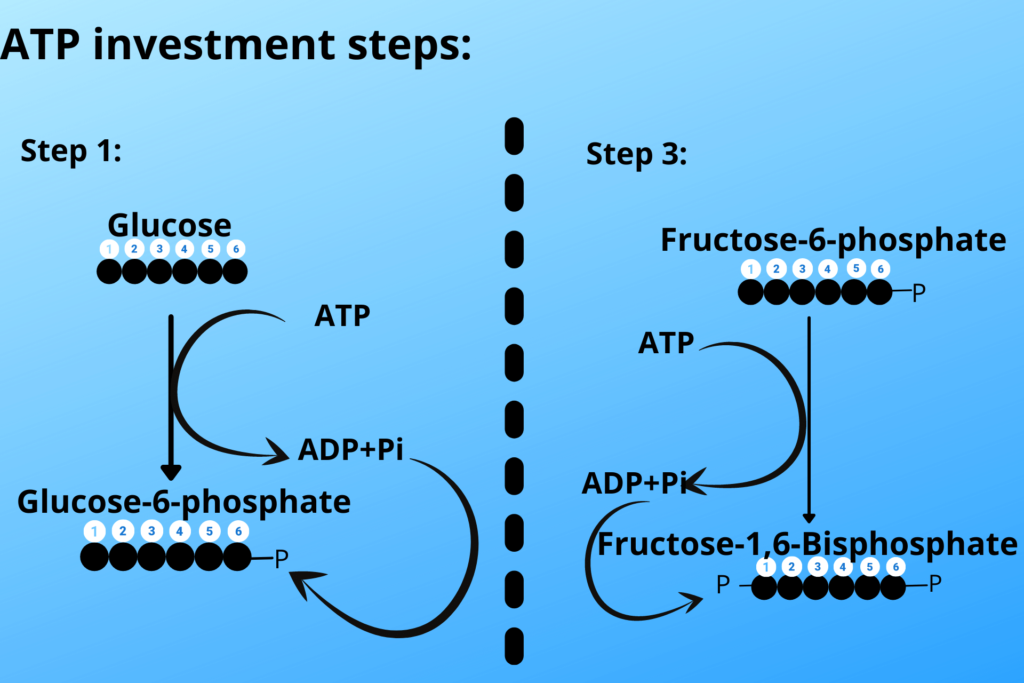
In the picture, step 1 invested one ATP in order to add phosphate to glucose to make it glucose-6-phosphate.
Step 3 also invested one ATP to convert Fructose-6-phosphate to glucose 1, 6 bisphosphates.
These are the energy investment phases.
Now going to energy gain phases and stages.
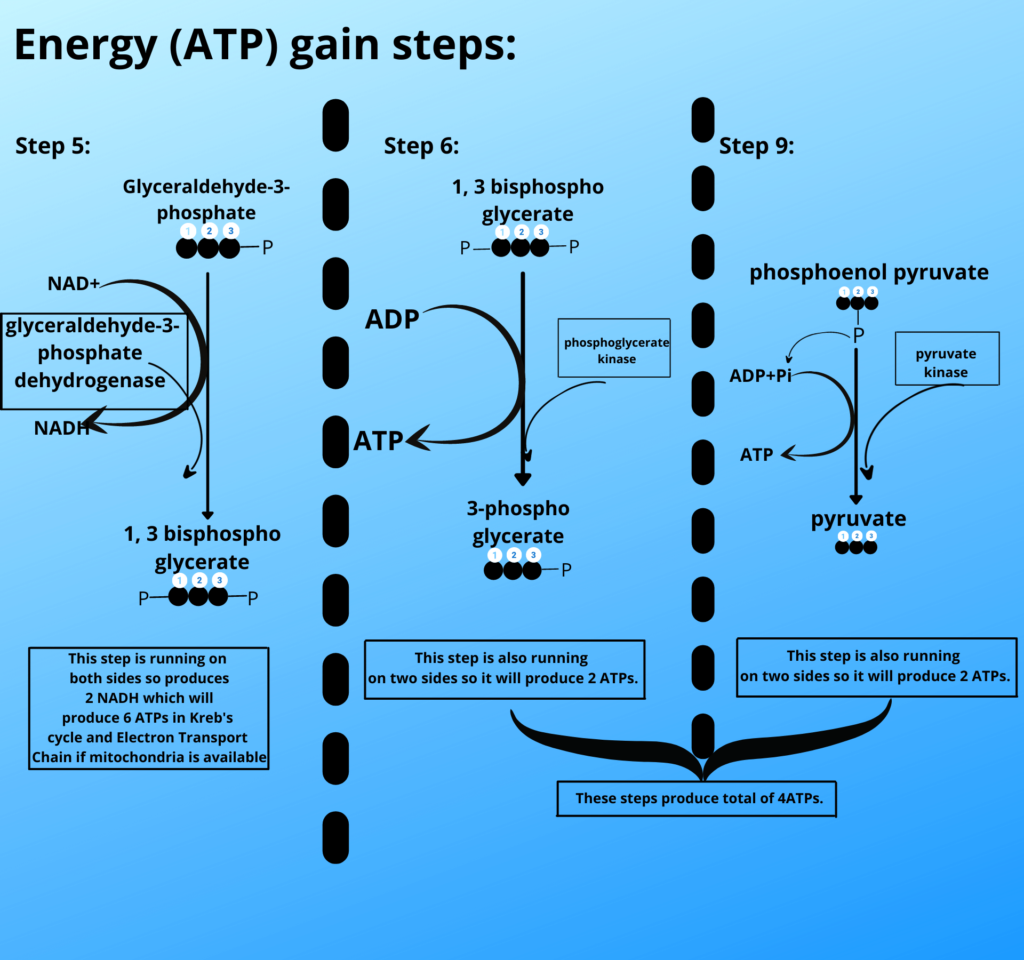
In step 5, the energy released from the conversion of glyceraldehyde-3-phosphate to 1, 3 bisphosphoglycerate is used to generate NADH (2 NADH from both sides), which will produce 3 ATP (total 6 ATPs) in the next phases if mitochondria are available.
Step-6 (1,3 bisphosphoglycerate to 3-phosphoglycerate)and step-9 (phosphoenol pyruvate to pyruvate) both generate one ATP (total of 4 ATPs from both sides).
So we invested 2 ATP and gained a net of 8 ATPs in which 4 ATPs are directly obtained while 6 ATPs are indirectly obtained if mitochondria in the cell are available.
Let me give you a simple calculation and straightforward answer to this question.
The total ATPs produced in glycolysis are 4.
But if we see the investment steps, then we invested two ATPs, so the net remains 2 ATPS, while 2 NADH further yields 6 ATPs indirectly.
What happens to glycolysis if no mitochondria are available, like in RBC?

This kind of glycolysis is called anaerobic glycolysis.
In other cells that have mitochondria, the NADH produced in glycolysis is transported to Kreb’s cycle where it produces ATP and returns back for glycolysis as NAD+ to repeat the process. But RBC has a limited supply of NAD+ which is consumed in glycolysis and also there is no Electron transport chain and citric acid cycle so after the formation of ATP it reverses back to glycolysis.
It means now NADH is stuck?
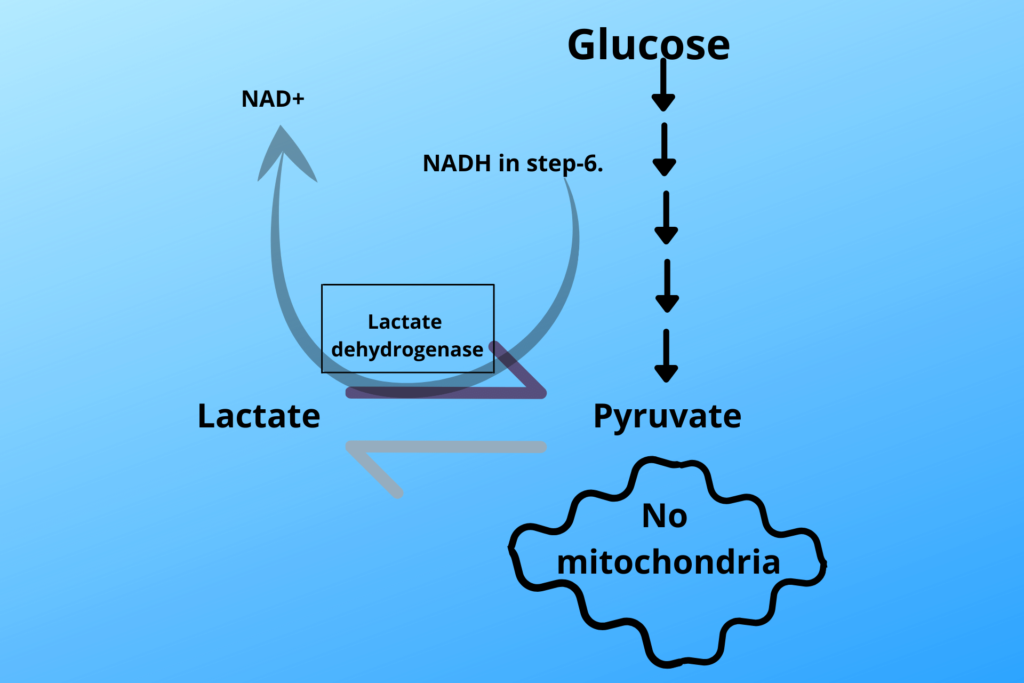
Not really, nature created everything perfect. To produce back the NAD+ the pyruvate is converted to lactate by an enzyme lactate dehydrogenase and in the same way, the NADH is converted back to NAD+ so that RBC repeats the glycolysis.
But how the enzyme knows that I have to convert pyruvate to Lactate?
When the concentration of NADH rises in the cell, the enzyme Lactate dehydrogenase knows that it is time to convert pyruvate to Lactate because lactate dehydrogenase is very sensitive to NADH concentration.
So how much NADH and ATPs are produced in the anaerobic glycolysis of RBC?
The NADH produced in the glycolysis is consumed back so there is no net production of NADH while a net of 2 ATPs is produced in the RBC glycolysis.
Is this amount of energy enough for RBC?
Yes, this meager amount of energy is enough for RBCs to run their metabolic process.
Can you tell us where the lactate then goes?
Well, let me give you a situation. For example, you are doing severe exercise so the cell will shift to anaerobic glycolysis and will produce a lot of lactate. The lactate is then supplied to the heart and liver through blood because these two organs love lactate.
For what?
The heart and liver convert it back to pyruvate and will transport it to the citric acid cycle and Electron Transport Chain.
Summary/Conclusion:
In conclusion, glycolysis is a complex process that produces a total of 4 ATP (net of 2 ATP molecules) from one glucose molecule. The first step of glycolysis requires the use of 2 ATP molecules, but the later steps produce 4 ATP molecules. This means that there is a net gain of 2 ATP molecules from glycolysis.
Glycolysis is an important process in cellular respiration, and it is the first step in the breakdown of glucose. Glycolysis provides the body with energy that can be used for immediate needs, or it can be stored for later use.
In this article, every step of glycolysis is explained in detail with pictures and diagrams. If you look at the pictures and diagrams it will be enough to understand it.
I hope this article has helped you to understand glycolysis and how it produces ATP. If you have any further questions, please feel free to leave a comment below.
FAQs
Q: What is glycolysis?
A: Glycolysis is a series of chemical reactions that break down glucose into pyruvate. It is the first step in cellular respiration, and it is essential for the production of ATP, the body’s main energy currency.
Q: How many net ATP molecules are produced by glycolysis?
A: One glucose molecule can produce a net of 2 ATP molecules through glycolysis. This is because two ATP molecules are used in the first step of glycolysis, but four ATP molecules are produced in the later steps.
Q: What are the end products of glycolysis?
A: The end products of glycolysis are pyruvate, NADH, and ATP. Pyruvate can be further broken down in the mitochondria to produce more ATP, or it can be used to produce lactate or ethanol. NADH is a coenzyme that can be used to produce ATP in the electron transport chain. ATP is the body’s main energy currency.
Q: Where does glycolysis occur?
A: Glycolysis occurs in the cytoplasm of all cells. It is aerobic, meaning that it does not require oxygen.
Q: What is the role of glycolysis in providing energy for the body?
A: Glycolysis provides the body with energy that can be used for immediate needs, or it can be stored for later use. Glycolysis is especially important for providing energy during exercise when the body’s demand for energy is high.
Q: What is the role of ATP in glycolysis?
A: ATP is the body’s main energy currency. It is used to power many cellular processes, including muscle contraction, protein synthesis, and the transport of molecules across cell membranes.
Q: What is the role of NADH in glycolysis?
A: NADH is a coenzyme that can be used to produce ATP in the electron transport chain. The electron transport chain is a series of reactions that take place in the mitochondria and produce ATP from NADH and other electron carriers.
Q: What is the difference between aerobic and anaerobic glycolysis?
Aerobic glycolysis is the type of glycolysis that occurs in the presence of oxygen. Anaerobic glycolysis is the type of glycolysis that occurs in the absence of oxygen.
Q: What are the implications of glycolysis for disease?
Glycolysis is involved in many diseases, including cancer, diabetes, and heart disease. For example, cancer cells often rely on glycolysis for energy, even in the presence of oxygen. This is why cancer cells are often more sensitive to treatments that inhibit glycolysis.
Sources:
https://members.drnajeeblectures.com/s/courses/64adb4eae4b061a7c01ce795/take






4 thoughts on “How many net ATP molecules are produced by the glycolysis of one glucose molecule?”